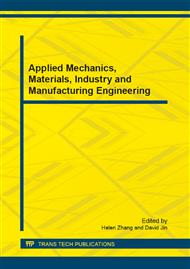p.30
p.33
p.37
p.42
p.47
p.52
p.55
p.59
p.65
Ferroelectric and Optical Properties of BST/BZT/BST Sandwich Structure Thin Films Prepared by RF Sputtering
Abstract:
In this work, (Ba0.65Sr0.35)TiO3 (BST) and Ba(Zr0.20Ti0.80)O3 (BZT) ceramic targets were prepared using the traditional solid-state reaction technique, which were sintered at 1200 °C for 2 h. The thin films of BST, BZT and sandwich structure BST/BZT/BST were grown on Pt/Ti/SiO2/Si(100) and Si(100) substrates by rf-sputtering at 500 °C, respectively. And all samples crystallied at temperatures 650 °C for 30 min in oxygen atmosphere. The cross-sectional images of the thin films were characterized by scanning electron microscope (SEM). The dielectric constant and dissipation factor tan of the BZT, BST and BST/BZT/BST thin films are 680 and 0.030, 240 and 0.021, 85 and 0.018, respectively at 100 kHz. Compared with BST and BZT films, the BST/BZT/BST film has lower dielectric constant and lower dissipation. The remanent polarization (Pr) of the sandwich structure BST/BZT/BST thin film is up to 9.57 μC/cm2, the Pr value is larger than that BST (0.25μC/cm2) film and BZT (8.45μC/cm2) film. The optical properties (refractive index n and extinction coefficient k) of the BST/BZT/BST film on Si(100) substrate were measured by n & k analyzer 2000.
Info:
Periodical:
Pages:
47-51
Citation:
Online since:
April 2012
Authors:
Price:
Сopyright:
© 2012 Trans Tech Publications Ltd. All Rights Reserved
Share:
Citation:


